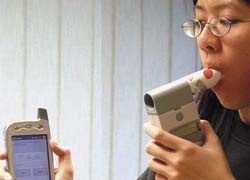Mobiles to monitor asthma and diabetes
UK - A hand-sized, electronic peak flow meter, which measures lung capacity and can be connected to a PDA mobile handset is being tested for use by asthma sufferers.

The system
Asthma sufferers will use the peak flow meter at home in the morning and evening and the system, made by e-San Ltd*, transmits the readings in real time to a central server, over a GPRS connection. An electronic patient diary on the PDA also allows the patients to enter information describing their symptoms and this data is transmitted at the same time as the peak flow readings. If no readings have been received for more than a day, a text message is automatically sent to the patient’s phone.
At any time, GPs or Practice Nurses can access their patients’ data stored on the server, enabling them to monitor the patients’ condition with up-to-date, accurate and reliable data.
The e-San solution is currently undergoing trial in a 100-patient study sponsored by O2, which is providing the mobile phone equipment (O2 xda) and GPRS network access.
Careful monitoring of lung function using peak flow meters improves control of the condition and reduces the risk of an acute asthma attack. However, e-San points out that most asthmatics do not always record peak flow values accurately in their patient diary (reviewed retrospectively at the Asthma Clinic every three months), and they often record nothing for several days. The new equipment could ensure monitoring and quicker essential treatment following any deterioration in the patient’s condition. Clive Peggram, CEO of e-San, foresees mobile monitoring of conditions such as asthma, diabetes and high blood pressure as a future norm.
Diabetes: e-San has also developed an integrated monitoring device for diabetics, which combines an electronic blood glucose meter and a GPRS mobile phone. The patient switches the blood glucose meter on, connects the cable from the meter to the phone and places a drop of blood onto the reagent strip. Within a few seconds, the blood glucose reading is available at the central e-San server. A few seconds later, entries from the patient diary regarding insulin dose, meals and physical activity are also available at the server, the firm reports.
This system is being evaluated in a randomised controlled trial (sponsored by the Vodafone Group Foundation) involving 100 young adults with Type 1 diabetes. Incoming readings are monitored on the server and intelligent software will automatically alert a Diabetes Specialist Nurse to support individuals when blood glucose levels have moved outside a personally targeted zone.
*e-San Ltd, based in Oxford, is a spin-off from the Neural Networks and Signal Processing research group in the Department of Engineering Science at the University of Oxford. The research group, run by Professor Lionel Tarassenko FREng, is recognised as a centre of excellence for medical signal analysis.
30.04.2003











